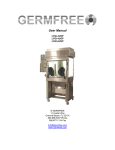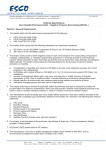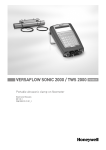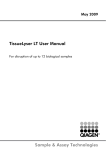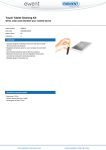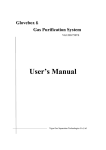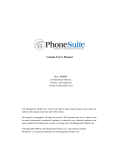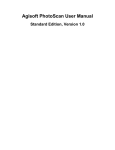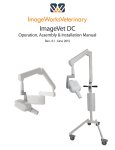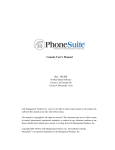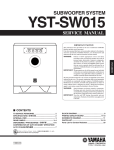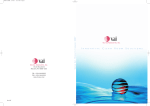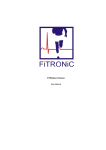Download pdf
Transcript
1 2 Table of Contents Receiving Instructions 1 Electrical Requirements 3 Certification 3 Safety, Operation and Additional Professional Training 4 Product Protection 4 HEPA Filtration Theory 5 Unidirectional Air Flow 6 VersaFlow Components Identifier 7 Initial Cleaning 10 Operation 11 Practice Proper Aseptic Technique 12 Rigorous Cleaning 13 Light Cleaning – Between Preparations 14 Cleaning Agents 15 Cleaning Terms 16 Light Bulb Replacement 17 Filters 18 Two-Part Glove System 18 Procedure for Changing Gloves 19 Sleeve Change 22 Alarm – Trouble Shooting 22 Available Options 23 Warranty 24 3 Receiving Instructions The Compounding Aseptic Isolator is shipped fully assembled in a single crate. All equipment must be inspected immediately upon receipt. If there is visible damage to the container or unit it must be noted on the receiving documents by the driver. The carrier must then be notified to arrange for an immediate inspection to verify the damage to the equipment. If damage to the unit is found after it is uncrated (concealed damage), the receiver should notify the delivering carrier at once. Do not move the equipment or discard any of the shipping materials until a concealed damage inspection is performed. If the carrier will not perform this service, please contact our factory immediately at 800- 888-5357, ask for the shipping department. Without this inspection of the equipment and packing materials, the freight company may not accept a claim for damage or loss and take the position that the damage occurred after delivery. Packaged VERSAFLOW 1. The VERSAFLOW is on a skid with a riser to prevent movement during shipment. 2. Additional prefilters are included and packaged under the hood. 3. The unit is stretch wrapped and strapped to the skid. 4. Protected by corrugated cardboard. 5. The skid is accessible for a pallet jack. Unpacking the VERSAFLOW 1. 2. 3. 4. Remove the corrugated cardboard. Remove the metal strapping. Remove stretch wrap. 3-4 people may be needed to lift the VERSAFLOW off the skid. **Caution: The VERSAFLOW is top heavy** 5. Unlock the casters and roll the VERSAFLOW to its final destination. 1 Contents Packed in Airlock 1. Preassembled Sleeves and Gloves 2. Maintenance kit (the white box): ü User Manual ü Selco Shine Stainless Steel Polish ü Abrasive Pad ü Novus Acrylic Scratch Remover ü Alcohol Wipes ü Complimentary set of Gloves ü 1 – Yellow Electrical Outlet Cord 3. Any additional purchased sleeves. 2 Electrical Requirements Electrical Requirements are as follows: VERSAFLOW-4USP standard wall outlet VERSAFLOW-6USP standard wall outlet 115V, 60 Hz, 15 amp, 10’ hospital grade power cord for 115V, 60 Hz, 15 amp, 10’ hospital grade power cord for It is essential that the equipment be properly grounded; it is a violation of your warranty to operate without. For service to the unit it is essential that the power cord outlet be easily accessible. If the Electrical Height Adjustment option was purchased it requires its own power receptacle and a 15 amp circuit on all sized units. Certification The Compounding Aseptic Isolator is a complete and self-contained unit whose performance was tested and documented before shipping. It requires certification after the unit has been installed and prior to operation. This is especially important after transportation of the VERSAFLOW from our factory to your facility. The purpose of this retesting is to verify that the HEPA filter, airflows and pressures are within limits and the unit is performing properly. It is always a good idea to review basic operation of your new VERSAFLOW with the certification company personnel due to their knowledge of this type of equipment. The VERSAFLOW certification needs to be performed by a company that has the proper equipment and training needed to test and measure HEPA filter performance. Recertification of the VERSAFLOW needs to be performed every 6 months or as regulations dictate. For a certifier listing in your area if you do not already have service, go to www.germfree.com and visit our Hospital Pharmacy Resource Center. For any additional information please contact GERMFREE at 800-888-5357. 3 Safety, Operation and Additional Professional Training The VERSAFLOW provides a contained environment that allows for greater protection for both personnel and product than traditional open front laminar flow equipment. However, this protection can only be achieved through proper technique. The following is a list of topics that may apply to your operation. Many of these items may require additional professional study and practice beyond the information found in this manual. 1. 2. 3. 4. 5. 6. 7. 8. 9. 10. Operation of the VERSAFLOW Understanding HEPA particulate filtration Proper operator technique Understanding chemical compatibilities for proper glove selection Understanding chemical compatibilities for proper “cleaning” and “sterilization” Understanding chemical compatibilities for proper “decontamination” Understanding sterile product preparation and aseptic technique Understanding hazards associated with the products handled in the VERSAFLOW Understanding proper maintenance and initial and periodic certification Understanding Federal, State and Local applicable professional regulations. To obtain this information and understanding may require additional professional training. If you need assistance in finding Professional Pharmacy Organizations offering additional training for any of the above items please call Pharmacy Equipment Sales at GERMFREE, 800.888.5357 Product Protection The Compounding Aseptic Isolator offers the highest level of product protection by providing vertical unidirectional (laminar) flow HEPA filtered air to the complete work environment. The unit utilizes a full width and depth supply HEPA filter above the work surface. This provides a better than ISO Class 5 particulate-free environment. Particulates generated by manipulations are continuously removed, maintaining ISO Class 5 or better conditions when operational. All air entering the VERSAFLOW is twice filtered, once by the pre-filter then by the supply HEPA filter. 4 HEPA Filtration Theory The Compounding Aseptic Isolator uses HEPA (High Efficiency Particulate Air) filters to provide the highest level of product protection. These filters are the laminar flow supply HEPA filter, which filters all air passing over the entire work area. All filters are rated to remove particulates and aerosols 0.3 micron in size with a minimum efficiency of 99.99%. These filters are even more effective at removing particulates both larger and smaller than 0.3 microns as the graph below depicts. Personnel and product protection from gas and fumes are not provided by HEPA filtration. 5 HEPA filters are recognized as one of the finest forms of mechanical air filtration available for this application. HEPA filters improve or become more efficient as they load under use. There are a number of mechanisms involved in HEPA filtration which is briefly presented below: 1. Impingement - Large particulates, e.g. dust, are captured by the filter fibers as the air stream flows around the fibers. 2. Interception - Particulates follow air stream around filter fibers and become captured (physical interference between particles and fibers). 3. Diffusion - Very small “particles” are bombarded by gas molecules causing them to move erratically (Brownian motion) and contact the filter fibers. 4. Straining - Occurs when the smallest dimension of the particulate is greater than the distance between adjoining filter media fibers. 5. Electrostatic attraction - Enhances mechanical capture through attraction of oppositely charged particles. Unidirectional (Laminar) Air Flow The Compounding Aseptic Isolator offers the highest level of product protection by providing vertical laminar flow HEPA filtered air to the complete work environment. This is the same technology used in the Laminar Flow Workstations and Biological Safety Cabinets that “Compounding Aseptic Isolator” are intended to replace. The Compounding Aseptic Isolator utilizes a full width and depth supply HEPA filter above the work surface. Any particle-laden air is swept from the work area with a wash of HEPA filtered air. Filtered air washes over the work area into the front and rear grilles. Particles that are generated by the work are immediately washed into the returns and out of the work zone. Internal cross-contamination from compounding different products in the same work area is drastically reduced. 6 Components Identifier Front of VERSAFLOW 1 2 1. 2. 3. 4. 5. 6. 7. 8. Prefilter Housing Control Panel Light Housing Gloveports Viewing Panel Airlock Door Latch Optional Electric Lift Height Adjustment Switch 9. Casters 3 4 5 6 7 8 9 7 Inside the Work Area 1 1. IV Bar 2. Inner Airlock Door 3. Work Tray 2 3 1 2 1. Diffuser Screen 2. Electrical Outlet 3. Optional Sealed Data Port 3 8 Control Panel 6 1 2 3 8 4 5 7 1. 2. 3. 4. 5. 6. 7. 8. Digital Pressure Gauge Low Pressure Alarm Low Pressure Pilot Light Main Blower Switch Light Switch Circuit Breaker Light Cable Speed Control (for certifier use only) Side View 1 2 3 4 5 5 1. Supply HEPA Filter and Motor Housing 2. Main Power Cord 3. Junction Box for Work Area Electrical Outlet 4. Gas Shock Window Lift 5. Optional Sealed Data Port 9 Initial Cleaning Exterior The outside of the VERSAFLOW can be cleaned at any time while the unit is closed and the procedure does not require Personal Protective Equipment (PPE) additional to that normally used when operating the VERSAFLOW. The stainless steel should be cleaned using a 70% isopropyl alcohol solution or a solution specifically designated for the cleaning of stainless steel. The acrylic front should be cleaned with a soft cloth and a mild detergent, or a solution specifically designated for the cleaning of acrylic surfaces. Do not use ammonia based cleaner on the acrylic. It is important to never use abrasive cleaners or organic solvents on the acrylic components. Additionally, the acrylic should not be cleaned with any solution stronger than 50% ethyl or 70% isopropyl alcohol. Interior Open the front access window and allow the VERSAFLOW to continue running during the cleaning process. A water-based, high pH, disinfectant cleaner should be used, followed by 70% alcohol. This cleaning method, when properly performed, prevents dripping of dirty solution onto cleaned surfaces and does not carry contaminants from surfaces near the open front of the work area to the rear. 10 Operation The VERSAFLOW must be certified before use. It is recommended to perform several trial runs in the Compounding Aseptic Isolator before initiating preparation. 1. Ensure the prefilter is fitted properly in its housing at the top of the unit. You should not see it above the stainless steel frame. 2. Ensure the VERSAFLOW is plugged into a functioning outlet. 3. Turn on the light switch. 4. Open the viewing panel and inspect under the work tray. Make sure there is nothing below the work trays. Remove any foreign objects from the work area. 5. Push the black nylon end of the electrical outlet into the receptacle located at the top right corner of the work area and tighten the retaining ring. 6. Install Sleeves and Gloves. Please refer to page 19 – Procedure for Glove Changes. 7. Inspect Gloves and Sleeves for any tears. Please refer to page 18 - Two-Part Glove System. If appropriate, change gloves to the preferred type and size. 8. Ensure both airlock doors are closed. 9. Turn on the main power switch. The low pressure alarm will sound until adequate pressure is achieved. 10. A minimum of 10 minutes for start-up time is needed to achieve ISO Class 5 cleanliness. 11. If purchased the optional Electrical Height Adjustment, adjust the height of the unit to a comfortable working height. 12. Be sure the inner airlock door is closed. Always close one airlock door before opening the other. 13. Place compounding elements into the airlock, wipe down. 14. Remove hands from the airlock and close. 15. Wait at least 10 seconds before bringing compounding elements into work area. 16. Begin preparation. 17. Dispose of waste through the sliding airlock door using the sealed bag method. 18. Remove completed preparation from the work area through the airlock. 11 For safe and efficient use of the Compounding Aseptic Isolator you should take into account the equipment and materials necessary for the proposed operation and list the procedural details for each operation. The best way to accomplish this is through the use of a checklist and/or protocol that includes all equipment, apparatus, tools, products and supplies necessary for each specific procedure. The list should include the order of events in enough detail to successfully carry out the proposed operation. This list needs to include such items as initial cleaning equipment, spill control equipment and even extra gloves in case a change is required in the middle of the operation. Always operate with critical sites in first air. This may take practice since the source of the HEPA filtered air is now above the user instead of in front, as in the commonly used Horizontal Laminar Flow Workstation. The VERSAFLOW is not a substitute for good aseptic technique. It will provide a clean environment for compounding but can be defeated with poor technique and disregard for cleaning and operational procedures. Practice Proper Aseptic Technique The Isolator family of equipment is no different than that of the Laminar Flow Workstation or the Biological Safety Cabinet- the equipment is a tool to aid the operator in maintaining a clean environment for the compounding of preparations. The equipment will never be a substitute for proper aseptic technique. If the environment is not cleaned well or the operator’s technique is poor, an aseptic media fill test will usually reveal the inadequacies. Never block air grills, do not operate without gloves or sleeves, or place anything other than compounding elements in the work area or this will compromise the workability of the unit. During operation be sure to disinfect and sanitize the work area at the beginning and end of each shift and after any large spills. Change your hand gloves regularly. Use the proper glove size to maximize operator comfort and follow all existing internal procedures and policies. 12 Cleaning the VERSAFLOW- Heavy Duty (Rigorous) Exterior The outside of the VERSAFLOW can be cleaned at any time while the unit is closed. The procedure does not require Personal Protective Equipment additional to that normally used when operating the VERSAFLOW. The stainless steel should be cleaned using a 70% alcohol solution or a solution specifically designated for the cleaning of stainless steel. The acrylic front panel should be cleaned with a soft cloth and a mild detergent, or a solution specifically designated for the cleaning of acrylic surfaces. It is important to never use abrasive cleaners or organic solvents on the acrylic components. Additionally, the acrylic should not be cleaned with any solution stronger than 50% ethyl or 70% isopropyl alcohol. Do not use glass cleaner with ammonia. Work from top to bottom. Do not remove or spray the prefilter at the top of the unit. NEVER spray any type of cleaner directly at the control panel located on the front top where the gauges are. Always spray onto a clean wipe and then wipe the surface, switches and knobs. Interior A water-based, high pH, disinfectant cleaner should be used, followed by 70% alcohol. This cleaning method, when properly performed, prevents dripping of dirty solution onto cleaned surfaces and does not carry contaminants from surfaces near the open front of the work area to the rear. 1. Open the front access window. 2. Spray disinfectant cleaner on a lint-free cleaning wipe. Wipe the filter diffuser in the top of the work area wiping from side to side, overlapping strokes. Work outward from back to front. Do not spray cleaners directly toward the Supply HEPA filter- always spray the cleaner onto the cleaning wipe then clean the filter protector surface. 3. Spray the back wall of the work area. Wipe the wall beginning at the top and wipe top to bottom using overlapping strokes working downward toward the work surface and wipe the rear air return grill. Work sideways from left to right. 4. Spray the sides of the work area. Using overlapping strokes, wipe top to bottom working downward toward the work surface. Be sure to clean the entire airlock door surface that is exposed to the inside of the work area, including the handle. 5. Lift the work tray, spray the inside and wipe in an overlapping strokes from side to side and back to front. 6. Remove glove sleeves and spray the inside of the open front access window. Using overlapping strokes, clean from top to bottom. 13 7. Spray a clean wipe with disinfectant cleaner and use it to clean glove ports. 8. Spray a clean wipe with disinfectant cleaner and use it to clean IV hanging bar and hooks. 9. Spray a clean wipe with disinfectant cleaner and wipe the front air return grill. 10. Close the front window. Clean the glove sleeves and gloves and replace on the front window. 11. Open the front window and repeat steps 1-13, without removing the sleeves and gloves, with sterile water to rinse away any disinfectant. 12. Turn on the VERSAFLOW and close the front access window. 13. Spray 70% IPA directly on all surfaces of the rest of the work area, under sliding work trays, the inside of the front access window, gloves and sleeves. 14. Allow the VERSAFLOW to run for 10 minutes before use. Inside the Airlock 1. Follow the same steps as cleaning the inside of the VERSAFLOW. Cleaning the VERSAFLOW between preparations (Light) Sanitizing the VERSAFLOW work area between preparations is recommended to reduce the chances of cross contamination. 70% Isopropyl Alcohol is the most recommended agent for this task. 1. Open only the outer door of the airlock. Spray a clean wipe with alcohol and wipe the top and back HEPA filter covers. 2. Spray the remaining surfaces, including the tray with alcohol and wipe with overlapping strokes. 3. Leave the spray bottle in the airlock and close the outer airlock door. 4. Open the inner airlock door and remove the spray bottle. 5. Spray all vertical surfaces in the work area with alcohol and wipe from top to bottom with clean wipes. Use overlapping strokes moving left to right. 6. Spray the air grills and work surface with alcohol and wipe from left to right with overlapping strokes moving back to front. 7. Spray the sleeves and gloves with alcohol and rub together, then wipe off. 14 8. Spray the same surfaces lightly and allow to air dry. If all materials are wiped down prior to placement in the airlock, it should remain clean for a number of preparations in a row. Cleaning Agents Class Phenolic Compounds Recommended Use Bactericide, Fungicide, Tuberculocide, Viricide 70% Isopropyl Alcohol Solution Cleaning certain instruments, cleaning skin Chlorine Compounds Spills of human bodily fluids, bactericide, fungicide, sporicide at >1000ppm Sodium Hypochlorite Ordinary housekeeping of floors, furniture, walls, bactericide, fungicide, viricide (not as effective as phenols) Quaternary Ammonium Compounds (QUATS) Examples Hil-Phene, LpH, Metar, Vesphene Brand Bleach Solutions (Sodium Hypochlorite), Name Brand Products Decon-Cycle by Veltek Lysol® L-Stat Ultar Phene Medaphene® Amphyl® TexShield™ by Texwipe, Decon-Ahol® By Veltek Clorox, Cyosan, Purex Quatsyl Coverage Decon-QUAT 258, End-Bac, Hi 100® By Veltek Lysol®-IC Tor Alpha-Lemon QUAT by Alphasource This list is by no means comprehensive nor does it constitute endorsement by GERMFREE. Read the labels on the products you are currently using to categorize them then rotate cleaning agents to avoid developing any resistant strains. Contact your current disinfectant supplier or search the internet for purchasing information that is specific to what is being compounded in the VersaFlow. 15 Cleaning Terms Clean Free from disease or infectious agents <a pullorum-clean flock> <keep installations clean of TB infection> Deactivate 1 : to make inactive or ineffective 2 : to deprive of chemical activity Decontamination A process that reduces contaminating substances to a defined acceptance level. To make safe by eliminating poisonous or otherwise harmful substances, such as noxious chemicals or radioactive material. To rid of contamination (as radioactive material) Disinfect To destroy pathogenic microorganisms in or on any substance or to inhibit their growth and vital activity. To cleanse something so as to destroy or prevent the growth of disease-carrying microorganisms. To free from infection especially by destroying harmful microorganisms Sanitization That part of decontamination that reduces viable microorganisms to a defined acceptance level, normally achieved by using a chemical agent or heat. To make sanitary (as by cleaning or sterilizing) <if the apparatus is not properly sanitized, pathogens may be disseminated to subsequent patients —Journal of the American Medical Association> Sterilize To make free from live bacteria or other microorganisms. References provided by: The American Heritage® Stedman’s Medical Dictionary Copyright © 2002, 2001, 1995 by Houghton Mifflin Company. Merriam-Webster Medical Dictionary, © 2002 Merriam-Webster, Inc. The American Heritage® Dictionary of the English Language, Fourth Edition copyright © 200 by Houghton Mifflin Company. 16 Light Bulb Replacement The “T-5” fluorescent bulb used in the VERSAFLOW can be purchased from suppliers such as Grainger, MSC Industrial, or McMaster Carr. 1. Make sure the light switch is turned off. 2. Remove the external bolts that hold the housing to the outside of the viewing panel. 3. Check to make sure that the bulb has a good contact. This can be checked by giving the bulb a gentle turn a few degrees and then back to the lock position. Turn the switch on. If this bulb does not light it will need to be changed. 4. Hold the bulb firmly at one end, and rotate it one quarter-turn clockwise. This should put the end prongs in line with the loading slot. 5. Slide the bulb free. 6. Lower the end of the bulb carefully out of the socket. When one end is free, pull slightly and the other end should come out also. 7. Set the old bulb aside and lift a new bulb into the fixture. 8. Hold the bulb horizontally, and rotate the new bulb until the prongs on each end are lined up with the grooves in the socket. 9. Insert the prongs in the socket and rotate the bulb a quarter-turn in a counterclockwise direction. The bulb should click into place on each end. 10. Test the light at the switch. If the light still doesn't come on you may need to replace the ballast. Contact GERMFREE @ 800-888-5357 for this replacement part. 11. Replace the light housing and secure the bolts. 17 Filters Typical life span of a prefilter is 3 months but differing room conditions can require replacement more or less frequently. During the first 3 months of operation the pre-filter should be checked once per month to determine the average life span for your facility. Regular certification will dictate life spans and replacement schedules of the supply HEPA filter. Regular replacement of the prefilter will lengthen the life of your supply HEPA filter. One digital pressure gauge is an indicator of differential pressure between the blower inlet and the Supply HEPA filter. It is a qualitative indicator of the HEPA filter condition. Your certifier should note the starting pressure and monitor it periodically. A large change in readings in a short time period is indicative of possible failures. Typical HEPA filter life span is 3-5 years. The second digital gauge measures the differential pressure between the airlock and the work area. Two-Part Glove System We recommend a glove with a longer cuff length for use with the VERSAFLOW. The sleeve and “bracelet” system will accommodate almost any commercially available glove. Typical life span of the sleeves is up to 6 months and GERMFREE recommends that they are changed at this interval. A visual inspection of all glove and sleeve surfaces is recommended at the beginning and end of each day. Any tears or punctures would require a replacement. With the unit turned on the operator can run a hand on all surfaces to feel for any air moving into or out of the work area through imperfections in the surfaces. Soap solution can also be used. If the VERSAFLOW has pressure the soap will bubble at any cut, tear or puncture. 18 Procedure for Changing Gloves Your standard two-part glove consists of: 1 Glove Sleeve 1 Disposable Glove 1 Glove Over Sleeve (GOS), a 3” diameter ring with three grooves on the outside 2 Glove O-rings, rubber rings that can stretch to fit around the GOS 2 Sleeve O-rings, rubber ring that can stretch to fit around the 10” gloveport 1) Pull the Glove and Sleeve out of the work area so that the sleeve is inside out and pull the existing glove and securing O-rings off. Glove Over Sleeve 2) Fold the sleeve back over the GOS so that the end of the sleeve is even with the end of the GOS. 19 3) Stretch the Glove O-ring over the sleeve and secure in the last groove of the GOS (the one farthest away from your person). Glove O-Ring 4) Stretch the new glove cuff with both hands before trying to stretch it over the GOS will sometimes make the task easier as well as identify weaknesses in the glove before you get it into the work environment. Place the glove through the opening with the thumb pointing upward. Then stretch the glove over the GOS ring. 20 5) Take the second Glove O-ring and slide it over the glove, securing it in the GOS groove closest to you. Glove O-Ring 6) Push the entire glove and sleeve back into the work area. 21 Sleeve Changes As seen in this picture there are two grooves on the VERSAFLOW gloveport. The sleeve can be placed at either position and secured with the Sleeve O-ring. To change a sleeve during maintenance, simply remove the securing O-ring and pull the sleeve out of the work area and off of the gloveport. New sleeves do not come with GOS or glove Orings. Please save them from the existing sleeve. To order extras contact the GERMFREE parts department at 800-888-5357. Alarm When the low pressure alarm sounds, corrective action must be performed or the unit will require shut down to stop the alarm. Alarms are tested at the factory before shipping. Dramatic drops in pressure indicating possible containment failure are alarmed. Alarms will sound when operating work area pressures drops below 0.05 inches water column (i.n.w.c.). Troubleshooting for Alarm Sounding Cause Corrective Action Glove Rip/Tear/Removal Replace Glove Sleeve Rip/Tear/Removal Replace Sleeve Both Airlock Doors Open Close Both Airlock Doors View Panel not Sealed Ensure latches are fastened on view panel After corrective action is taken, allow 30 seconds for alarm to reset. Observe the digital read-out to ensure that the magnitude of the number is increasing. If number does not increase and alarm continues to sound call your certifier or the Technical Service Department for GERMFREE at 800-888-5357 for further troubleshooting. 22 Available Options Electronic Height Adjusting Stand (optional at time of purchase) The electronic height adjusting stand is powered by a motor housed at the back of the VERSAFLOW. Hydraulic lines run to a cylinder at each caster and are pressurized to move the work area up and released to lower it. This action is activated by a switch located under the work area on the outside of the unit. Direction is indicated by arrows on the switch. The electronic adjusting stand requires its own power outlet/plug. *When using the height adjustment it requires a five minute rest period between adjustment cycles. Sealed Data Port The next page gives instructions on how to use the sealed cable pass through if your unit is so equipped. You will find the vial of lubricant that is mentioned in the instructions in your cleaning kit. Use caution when setting the pass through up as it is mounted in the plastic side panel. Replacement cable modules are available if your needs change in the future, contact GERMFREE for more details. 23 24 Warranty Information (2 year standard) Limited Warranty GERMFREE warrants equipment to be free from malfunctions and defects in both materials and workmanship for two years from the original purchase date, unless otherwise indicated on the sales order/invoice. Limited Warranty Coverage THIS LIMITED WARRANTY WILL BE HONORED ONLY WITHIN THE GEOGRAPHICAL LOCATION/FACILITY THAT GERMFREE EQUIPMENT WAS PLACED. GERMFREE will REPAIR or REPLACE GERMFREE equipment if they fail to function properly during the warranty period, subject to any conditions and/or limitations stated herein. Such repair service may include labor as well as any necessary adjustments and/or replacement parts. Such repair or replacement is the sole remedy under this warranty. If replacement parts are used in making repairs, these parts may be remanufactured, or may contain remanufactured materials. If it is necessary to replace the entire product, it may be replaced with a remanufactured product. Limitations This warranty does not cover circumstances beyond GERMFREE’s control, nor problems caused by failure to follow the operating instructions in the GERMFREE equipment manuals. THIS WARRANTY DOES NOT APPLY WHEN FAILURE IS DUE TO SHIPPING DAMAGE, ACCIDENT, ALTERATION, MODIFICATION, UNAUTHORIZED SERVICE, MISUSE, ABUSE, USE WITH INCOMPATIBLE ACCESSORIES OR ATTACHMENTS, FAILURE TO FOLLOW GERMFREE’S OPERATION, MAINTENANCE OR REPACKING INSTRUCTIONS, OR CLAIMS MADE AFTER THE DURATION OF THIS WARRANTY. GERMFREE makes no other express or implied warranty for this product. In the event that the exclusion of any implied warranty is ineffective under the law, the duration of the implied warranty will be one year from the purchase date. The option of replacement is GERMFREE’s only obligation. GERMFREE will not be responsible for any special, consequential or incidental damages resulting from the sale, purchase, or use of this product, regardless of the cause. Liability for any special, consequential or incidental damages (including but not limited to loss of revenue or profit, downtime costs, loss of the use of the equipment, cost of substitute equipment, facilities or services, or claims of your customers for such damages resulting from the purchase, use or failure of the product), regardless of cause or for breach of any written or implied warranty is expressly disclaimed and excluded here from. Your Rights Some states or jurisdictions do not allow exclusion or limitation of incidental or consequential damages, so the above limitation or exclusion may not apply to you. 25 Some states or jurisdictions do not allow limitations on how long an implied warranty lasts, so the above limitation may not apply to you. This warranty gives you specific rights, and you may have other rights which vary from state to state or by jurisdiction. Outside the United States In countries other than the United States, the terms and conditions of this warranty may be different. Unless specific GERMFREE warranty is communicated to the purchaser in writing by a GERMFREE company, no warranty or liability exists beyond any minimum requirements imposed by law, even though defect, damage, or loss may be by negligence or other act. 26 VF – USP Parts List Rev.1 January 2007 Part Number Description VF-HF4S VF-PF4 VF-HF6S VF-PF6 VF-4USP Supply HEPA VF-4USP Prefilter (pkg 12) VF-6USP Supply HEPA VF-6USP Prefilter (pkg 12) VF-DPG VF-SC VF-SWITCH Digital Pressure Gage Speed Control Green Lighted Switch VF-SMB Supply Motor VF-A33B VF-A33BOR VF-A33OOR Additional Pair of Butadyl / Hypalon Sleeves 3-Groove GOS for Two-Part Glove/Sleeve (with 4 ORings) Black O-Rings for Gloveport (set of 2) Orange O-Rings for GOS / Trashport (set of 2) VF-A51M Replacement 4-cord module for sealed cable port Filters Control Panel Motor Sleeves VF-A33TGOS Accessories When your facility is interested in purchasing replacement parts, please contact our GERMFREE Parts Department at 800-888-5357. 27 1































